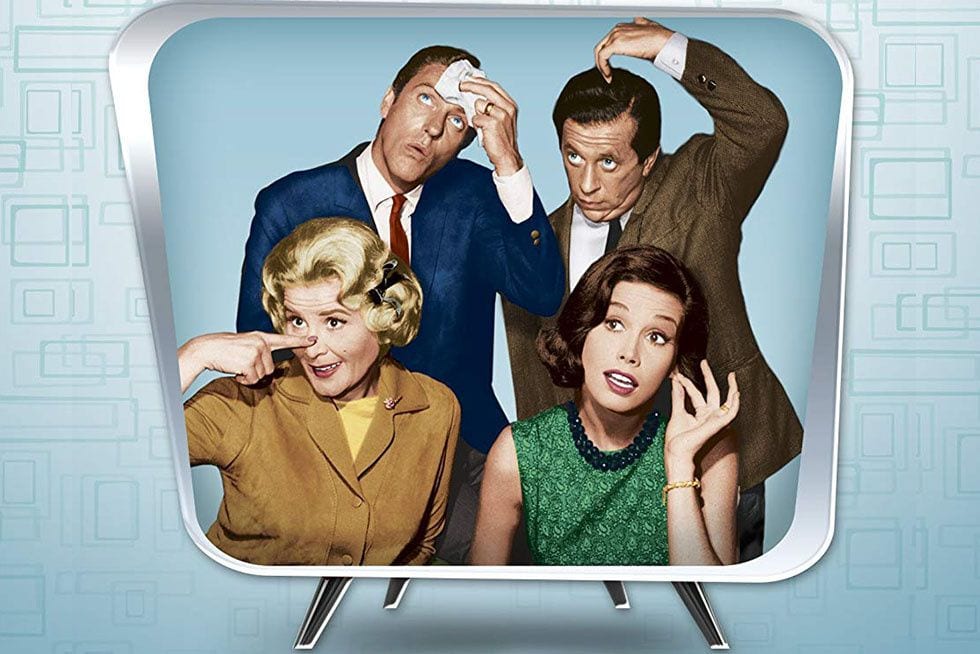
Why do so many queer people love to watch old sitcoms from the ’50s and ’60s? Aren’t these the very source of heteronormative policing that proliferated through American pop culture to oppress us? Nope, argues media and gender studies professor Quinlan Miller. Well, yes, on the surface or to the untrained eye—but also nope. His book on the subject, Camp TV: Trans Gender Queer Sitcom History, is the latest installment in the Console-ing Passions series from Duke University Press. The series itself, about 30 books deep already and still going strong, charts the implications of especially race and sexuality identity politics for television through a historical lens. Some of the subjects of its stand-out books focused on queerness include AIDS camcorder activism in the ’80s, tabloid culture in the ’90s, and make-over themed reality television in the ’00s.
Miller’s project is both valid and noble. He’s unmasking the myriad ways that early sitcoms were able to incorporate queer representation as well as gender nonconformity. By laying out a historical understanding of how television production was changing and mapping the general theoretical underpinnings of how sitcoms were structured and acted, Camp TV is able to articulate why queer people have always gravitated toward these television shows despite their glossily conservative surface messaging. When my wife and I have a rough day, we usually end it by snuggling up to an episode of The Dick Van Dyke Show—a sitcom that might at first appear not to reflect our politics or lived experience whatsoever. Camp TV gives ample analysis of a dozen or so specific episodes of our beloved show, with particular emphasis on the Sally Rogers character played by Rose Marie.
The Bob Cummings Show (NBC, CBS, 1955-1959) and The Ugliest Girl in Town (Sony, 1968-1969) are given a similarly detailed analysis. Though these two shows may be less familiar to most, Miller provides quite enough context to pick up on the merits of his examples. After all, these are sitcoms—viewers are meant to be able to drop in on one at any time and get traction on the archetypes and basic plot in about five seconds. There are also a huge number of shows addressed in somewhat less extensive examples, including The Beverly Hillbillies (CBS, 1962-1971), Bewitched (ABC, 1964-1972), Father Knows Best (CBS, NBC 1954-1960) and The Many Loves of Dobie Gillis (CBS, 1959-1963) just for starters. These are also many more modern quick takes, from The Brady Bunch (ABC, 1969-1974) to Will & Grace (original series, NBC, 1998-2003). Sometimes Miller looks at a specifically iconic scene or chunk of dialogue and other times he looks at a character’s overall role in a show.
The example content is wide ranging and effectively illustrative of Miller’s camp concepts. His notion of camp, as a performative characterization and an element of subcultural knowledge, is itself quite sound. Under the aegis of fluidity, Miller advances a trans-conscious viewpoint that happily takes a pick-ax to more basic gender studies approaches to pop media. Here’s an interesting litmus test: you can count his Judith Butler cites on one hand and he uses Susan Sontag’s “Notes on Camp” merely once. These critics are dinosaurs to Miller, yet their manner of voice has left indelible marks on the style of writing in Camp TV and this is not especially for the better. The book opens on a linguistic critique of current media scholarship and proceeds through an excellent analysis of sitcoms that’s too frequently marred by long dependent clauses, passive voice syntax, and needlessly academic vocabulary. Here are two sentences from page three and four of the introduction, intended to help explain the book’s subtitle:
“The concept ‘trans gender queer’ refers to the possibility of reading gender cues that are more specific than male and female, masculine and feminine. This is a possibility that existed (even though the term genderqueer did not) in the 1950s and 1960s, for example, people classified as ‘women’ who at that time produced, through performance and embodiment, effeminacy, the principal queer gender this book relates, understood as a stylized nonhegemonic antimasculinism, or, in other words, feminine and masculine ‘of center’ at once.”
Followed immediately by a footnote, of course. The comprehensive result of Miller’s writing choices simultaneously raises and lowers a reader’s esteem for this work. It’s clear that Quinlan fully comprehends his subject. And equally important, his word choice is not idling at the level of buzzy academic keywords, but genuinely doing the work of pinpointing the necessary concepts. His grasp of strong theory is admirable. However, it also makes for a viciously dense slog that regularly precludes a reader’s enjoyment.
Call me crazy, but a book on old sitcoms—no matter how philosophical—should provoke jouissance in the reader through submersion in the content examples, especially when the book’s overall project purports to go some distance toward reclamation of these old sitcoms from the demons of heteronormativity. But Miller’s writing takes all the fun out of thinking about camp. His tight knowledge should be tempered by a campy loosening of its display. I liked everything about this book, except that it was needlessly difficult to read. As this is Miller’s first book, he has certainly proven himself one to watch, even if he could use a bit of reflection on his own deployment of “stylized nonhegemonic antimasculinism”.

